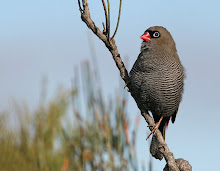Left Moora bright and early and made our way north to Payne's Find. I'm not sure what Payne found but it clearly wasn't much, just a roadhouse surronded mulga scrub. Being in such an isolated location we decided to top the petrol tank up and at $1.70 a litre we were glad it was just a top up.

From Payne's we turned right onto the Maranalgo Road trying to find Grey Honeyeater. We dipped of course but did see the western race of Southern Whiteface, White-backed Swallow, Crested Bellbird, White-fronted Honeyeater, White-browned Babbler, White-winged Fairy-wren and SLATY-BACKED THORNBILL.
A stop at Lake Austin (north of Mount Magnet) netted us five Orange Chats.

We finally pulled into Nallan Station (10km north of Cue) late in the day and had enough light for a quick stroll. White-plumed Honeyeaters were seen for the first time on the trip and the difference between the bright yellow western birds and our dull olive eastern blobs was quite staggering. We also encountered the red northern race of Grey-crowned Babbler.
Near the homestead we found another tick, WESTERN BOWERBIRD. The pink nape feathers glowed in the afternoon light.
 Day 10
Day 10Another early start saw us leaving Nallan and heading a few km's west of Cue on the road to Austin Downs station. At exactly 3.8km from town (Frank O'Connors website is fantastic by the way) we had 2 calling CHIMING WEDGEBILL. My impression of wedgebills was always of a
 bold bird perching out in the open calling but its quite the opposite. We found it hard to get a clear view through the binoculars, just fleeting views as they ran from shrub to shrub.
bold bird perching out in the open calling but its quite the opposite. We found it hard to get a clear view through the binoculars, just fleeting views as they ran from shrub to shrub.Further up the road we stopped at another of Frank's sights and scored our second tick for the day, 3 BANDED WHITEFACE. What a cute little bird and very different to their Southern cousin.
It was at this stage that we should have packed up the gear and headed west to the coast but silly us decided to stay on and find those mythical Grey Honeyeaters. The next 2.5 days were hell. Sure there were a few good birds around like the western Chestnut-breasted Quail-thrush, Bourke's Parrot, Black-capped Sittella, Crimson Chat, Black-breasted Buzzard, Redthroat and Mulga Parrots, but on the whole bird numbers were down and hard to come by. We spent alot of time dozing, reading (oh thank you Angels & Demons.....strongly recommended
Day 13
HEADING SOUTH!!!!!! We were so chuffed to be leaving the dry mulga country we didn't stop the car until we hit the wheatbelt again. Pallid Cuckoo were seen several times beside the road, as were White-fronted Chats. Western Corellas seemed to be everywhere (sorry Dave).
We couldn't leave Western Australia without seeing the famous Northam MUTE SWANS. After much deliberation with other birders once we got home we've decided to tick these birds as the remnants of a once sustainable population. We've also heard a report of recent breeding.
 Day 14
Day 14Spent an absolutely gorgeous day birding around Rockingham and Armadale. Nothing overly exciting was seen but just being back in civilisation and being near the turquoise blue waters off Perth made for a great days birding. A few highlights included Red-winged Fairy-wren, White-breasted Robin, 3 species of Black-cockatoo, Western Thornbill, Western Wattlebird, Western Thornbill, Scarlet Robin and a pair of Western Gerygones building a nest.
 Day 15
Day 15Our last day in Western Australia and Rottnest Island was calling. Everyone will be glad to hear that I made it across without being sea sick (Hazzah!!). Nick and I walked many kilometres in the sun with no breeze to help us and with little reward.......oh.....except that stunning little corker known as a RED-NECKED PHALAROPE! What a tiny little bird, dwarfed by the nearby Banded Stilts.

We walked the golf course many times in search of Pheasant but failed, we did however see many Quokkas, furry footballs in my mind
Our last bird for the day before jumping on the return ferry to Fremantle was a ridiculous looking male PEACOCK, strutting its stuff through the settlement amongst the tourist.
So after 15 days on the road I had managed 12 ticks, totally cleaning up the South west and our trip list was 175 species strong.









